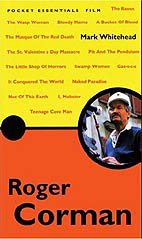 Book Reviews: April 2011

Between 1954 and 1970, legendary B-moviemaker Roger Corman (born 1926) directed some fifty films. These included such fantastically-titled pictures as Attack of the Crab Monsters (1957), Teenage Caveman (1958), The Wasp Woman (1959), Bloody Mama (1969), and Gas-s-s-s, Or it Became Necessary to Destroy the World in Order to Save It (1970). Additionally, he helmed the popular Early Sixties “Poe Cycle” of films, many starring Vincent Price, such as The Fall of the House of Usher (1960), The Pit and the Pendulum (1961), and The Masque of the Red Death (1964). Many Corman disciples favor his 1959-1960 “comedy/horror trilogy”: A Bucket of Blood, The Little Shop of Horrors, and The Creature from the Haunted Sea. Other Corman fans, however, prefer his Psychedelic Sixties work, The Wild Angels (1966) and The Trip (1967), both of which featured Peter Fonda. Corman directed for independent studio American International Pictures (AIP), headed by James H. Nicholson and Samuel Z. Arkoff. AIP’s “formula for success was simple: cheaply-made movies released as double bills for drive-in and independent cinemas that were excluded from showing the output of the Hollywood majors. For AIP, no subject went unexploited, no bandwagon was left un-jumped and the more topical the subject was, the better. From the anodyne ‘beach party’ movies…to the later Vietnam-influenced youth rebellion movies…Arkoff and Nicholson gave their audiences exactly what they wanted to see and ensured that they would come back for more. AIP’s greatest asset in achieving this goal was their most prolific director during the Fifties and Sixties: Roger Corman.” In Roger Corman (Pocket Essentials, $6.99, paperback), horror enthusiast Mark Whitehead, author of Slasher Movies (2000) and Jack the Ripper (2001), provides an informative, entertaining overview of the penny-pinching, brisk-working, hyper-productive filmmaker. “No one made them cheaper, faster or better than Corman.” Whitehead briefly discusses each of Corman’s films, offering cast, crew, story, and background information. He also provides a verdict on each feature. Assessing the Tower of London (1962), for example, Whitehead contends: “Despite his excellence in the Poe movies, Price’s performance in Tower becomes increasingly hammy towards the final battle. The low budget is on display in scenes such as the cut-price Battle of Bosworth Field and, despite some atmospheric moments, the cumulative effect is one of a cheap pageant of horrors rather than a truly horrific film about the corruptive nature of ambition. 3/5 [stars].” Whitehead’s text is comprised of an introduction and eight chapters: Roger Who? ; Early Days; Fast and Furious (1954-1958)—Cowboys, Aliens, Gangsters, Angry Teens and The End of the World!; Striking Out (1959-1960)—Demented Beauticians, Sculptors and Florists, and the Cheapest Epics Ever!; Without You I Am Nothing (1960-1965)—Poe, Lovecraft and The Intruder; Outside Looking In (1966-1970)—Drugs, Gangsters, Bikers and The End of the World (Again); In Production—New World, Concorde-New Horizons and Corman’s Return to Directing with Frankenstein Unbound; The Roger Corman Academy of Film Technique—A Brief Guide to Those Who Got Their Big Break Working With Corman; and Cormedia—Books and Websites With More Corman Tales. (Advancing age has not slowed Corman. In 2010, for example, he produced, among other projects, Sharktopus and Dinocroc vs. Supergator.) Evaluating his subject, Whitehead asserts, “What you come away with when researching Corman is a picture of a man capable of great things who, becoming inured to working under stifling financial and time constrictions, never allowed himself the luxury of breathing; a man obsessed with attaching himself to those who promised greatness but who, allowing himself a little slack, would have been capable of it himself…he tuned up some of the greatest directors [including Peter Bogdanovich, James Cameron, Francis Ford Coppola, Jonathan Demme, Ron Howard, and Martin Scorsese]…ever seen, but [Hollywood] never accepted him as one of their own. It’s no surprise that the favored theme of his movies is society’s outsider.” This volume belongs to the Essential Library Film Directors series, which includes books on Jane Campion, Clint Eastwood, Ang Lee, Sergio Leone, and Oliver Stone. Miniscule type (extremely difficult to read) and the lack of an index mar Whitehead’s study. Still, cinephiles, particularly Corman devotees and B-movie buffs in general, will appreciate his commendable publication. Two thumbs up! (Note: Corman admirers should also read his fascinating 1998 autobiography, How I Made a Hundred Movies in Hollywood and Never Lost a Dime.)
 |
 "Roger Corman" (Pocket Essential series)
"Roger Corman" (Pocket Essential series)